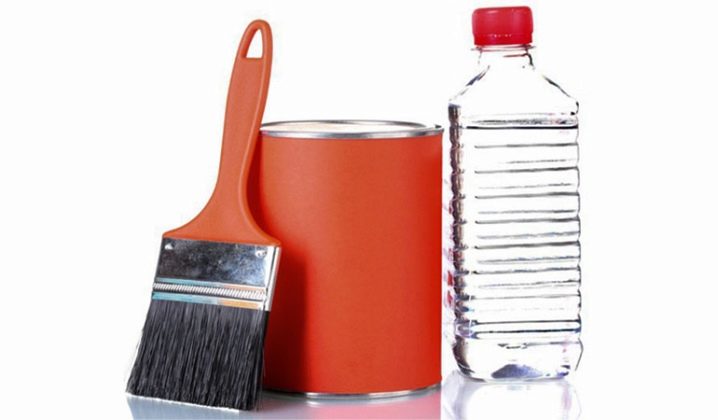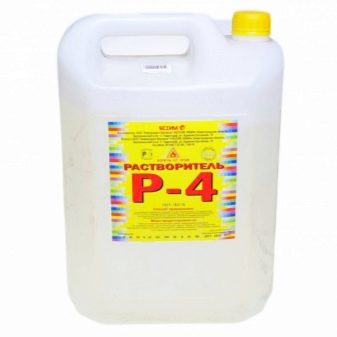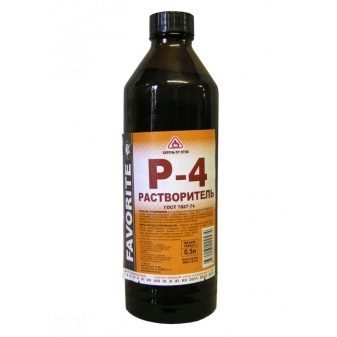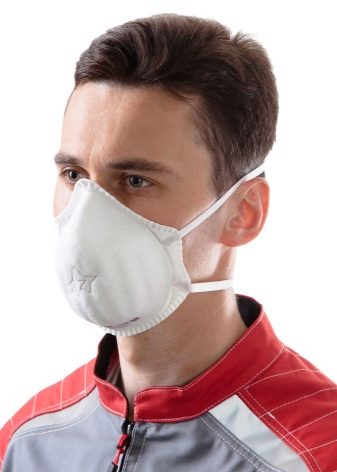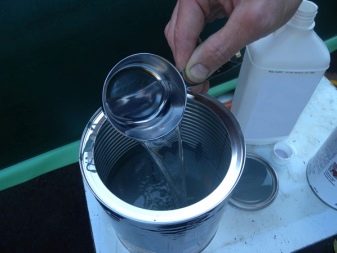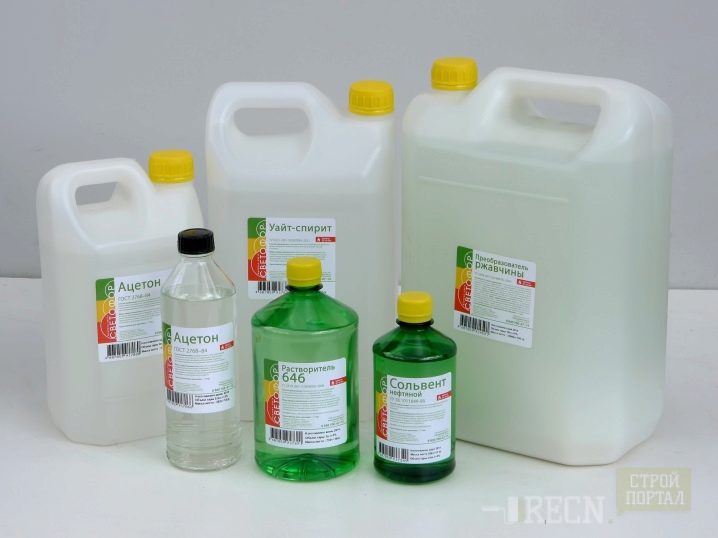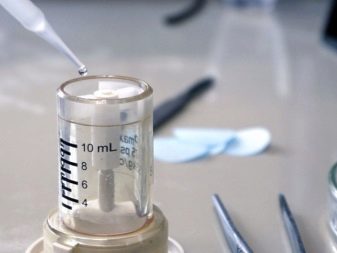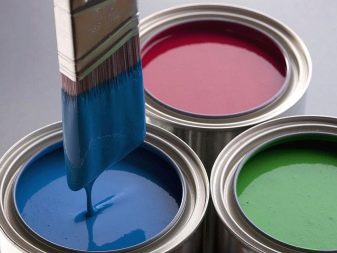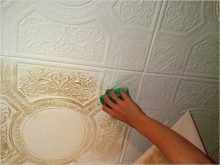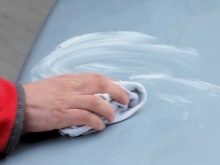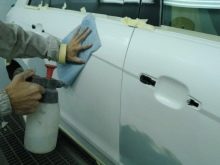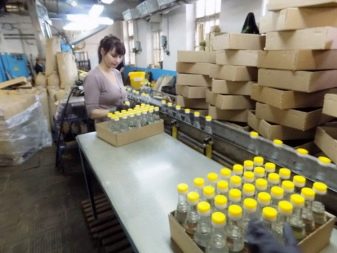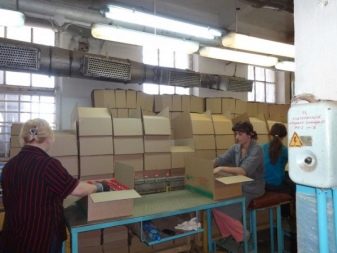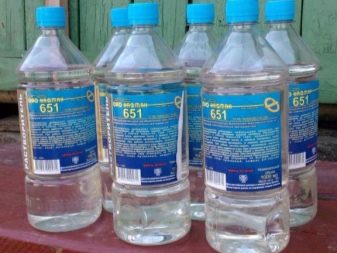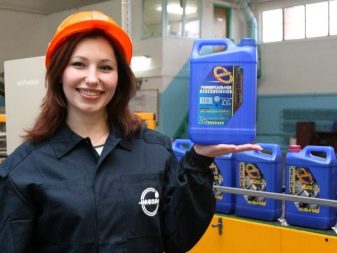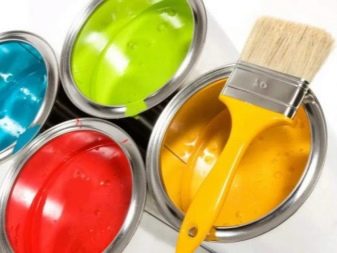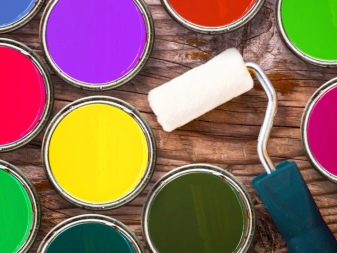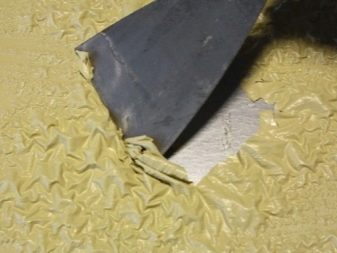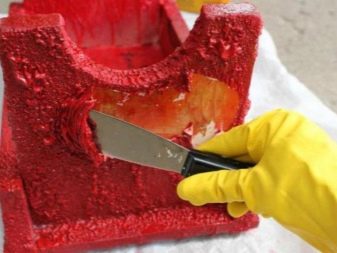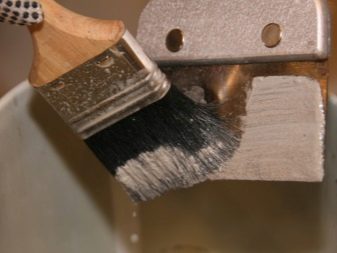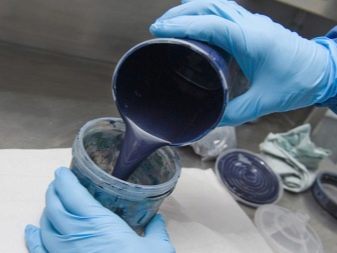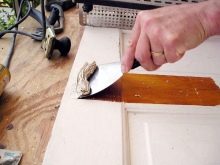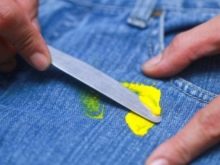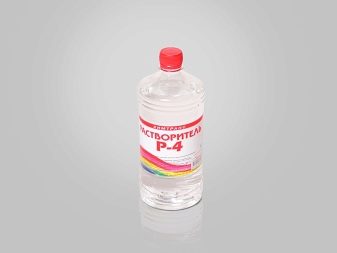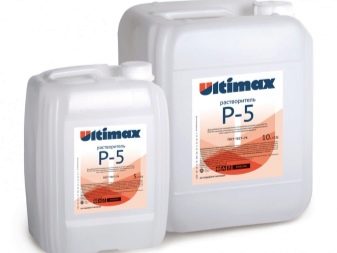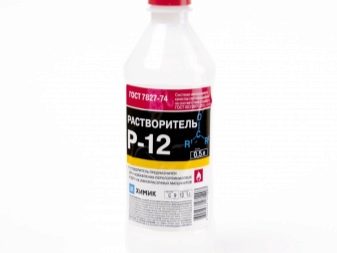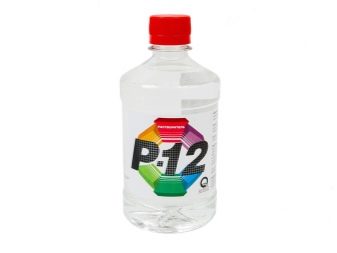Solvent Р-4: properties and features of application
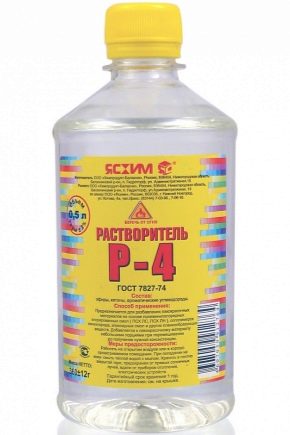
The use of varnishes and paints in production and in everyday life is often inconvenient due to their high density and viscosity. This inconvenience easily removes the solvent.
It is also needed to remove paint stains, degrease surfaces, and wash brushes after work. P-4 will do an excellent job with all these tasks.
Features and composition
Any solvent either belongs to the group of active chemical substances, or is a mixture of several components. Such a mixture of substances of organic origin and is a P-4.
It looks like a clear, colorless or yellowish liquid.in which there is no sediment or suspended particles.Substance has a sharp characteristic odor.
It has gained great popularity, as it has good consumer properties. R-4 is on sale in any specialized shop for reasonable price. In addition, having a wide range of applications, it is very easy to use. The description of the method of application and the composition are usually indicated in the instructions on the container with the substance.
One of the features of the P-4 is the possibility of its use for breeding virtually any paintwork material, making it economical to use. And also, P-4 gives them the ability to dry more quickly, and upon drying it forms a smooth shiny film that prevents fading of the coating.
It is necessary to ensure that in the process of working in the solvent does not get water. It will mix with acetone and this will cause white spots on the painted surface after drying.
Acetone and toluene are essential ingredients in the solvent. They are in P-4 26 and 62%, respectively. They expand the scope of its application. And butylacetate is added to the composition, which helps to protect painted surfaces from fading.
However, these substances can not be called beneficial to the human body. Although the penetration of the solvent onto the skin does not cause burns, prolonged contact with it and inhalation of vapors will not pass without a trace: poisoning, dizziness, cough, and dermatitis may occur.
Therefore, when working with a solvent, measures should be taken to protect the respiratory organs. You should also avoid getting liquid in your eyes. Works should be carried out in a well-ventilated area; gloves or mittens are useful.
Specifications
Solvent Р-4 is a volatile, self-igniting substance. However, spontaneous combustion occurs at a fairly high temperature — above 500 degrees C. Nevertheless, this is a flammable substance, and it requires caution in handling. You should not smoke near it, open fire and sparks should not be allowed.
It is necessary to take into account such an important indicator as the flash point. This term means a temperature indicator at which the solvent vapor mixed with air vapor ignites in the presence of open flame. For the P-4, the flash point is -7 degrees C.
During production, the substance is packaged in containers, the walls of which will not react with it in a chemical reaction. This is usually glass or plastic packaging. The solvent should be stored in dark rooms where good ventilation is established so that it is not affected by direct sunlight and moisture. The container should be tightly closed, and there should not be near electrical and heating devices.
Technical characteristics of the solvent are determined by state standards. They are usually indicated on the packaging. For P-4, this is:
- coagulation number - 24%;
- part of the water - 0.7%;
- volatility - 5-15;
- density - 0.85 m3;
- ignition temperature - 550 degrees C;
- flash point is minus 7 degrees C.
Packing solvent can be small and large. It depends on where it will be applied.
For domestic use, it goes on sale in containers of 0.5, 1, 3, 5, 10, 20 liters. In a 0.5 liter bottle the weight of the product will be 0.4 kg. In other containers - 0.7, 2.2, 3.7, 7.2, 14 kg, respectively, the specified volumes.
For industrial use large packaging. It can be 100 and 216 liters. In it, the weight of the product will be 72 and 165 kg, respectively.
Different manufacturers may have different packaging volumes and product weights. Manufacturers establish a warranty period of storage of the product in one year from the date of manufacture.
Scope of application
R-4 is extremely popular among people involved in the repair of premises, as it is almost universal and necessary for a wide range of works.
Most often it is used for painting work., as it is very effective for the high solubility of paints and varnishes used in interior decoration. It was specially developed for materials based on vinyl chloride, epoxy, polyvinyl chloride and chlorinated resins. It is suitable when you need to dilute or dissolve synthetic or natural film-forming compositions.
It should be noted that the use of solvent significantly reduces the cost of repairs, as its price is low, and the paint consumption in a more liquid consistency is significantly reduced. The quality of staining does not suffer.
Although the main purpose of the solvent is to dilute varnishes and paints, it can be used to clean and degrease surfaces. To do this, they wipe with a cloth moistened with solvent.
Dirt comes off very easily, and the solvent evaporates quickly, leaving a thin film. The resulting film is an excellent protective coating that will ensure the subsequent high-quality surface coating.
That brushes and other tools were not spoiled, they should be washed after work. However, this cannot be done with water and soap. R-4 will come to the rescue here.
Degreasing is also necessary for many other non-staining jobs. For example, for the subsequent application of glue or other compositions in the repair of shoes, furniture or appliances, when gluing broken pieces. The degreasing procedure can be performed using P-4.
Manufacturers
There are many manufacturers in the market today that produce solvents among other products.
One of the largest Russian enterprises - Dmitrievsky Chemical Plant.
Its history began more than a century ago. In 1899, a small manufactory producing acetic acid and its salts was founded by Savva Morozov. Over the long development path, it has become a modern company that manufactures products for various industries.The company continues to develop and monitors its reputation, exercising control over the quality of products at each stage of its manufacture. Therefore, many products, including P-4, are in demand not only in the domestic market, but also in 70 countries of the world.
Another well-known large manufacturer is the Belarusian plant. "Naftan".
This is a relatively young company, its construction began in 1958. His birthday is considered February 9, 1963, when gasoline was first produced in Belarus. The company developed by leaps and bounds, technologies are constantly being improved, the efficiency of production processes is increasing.
In addition to production capacity, the plant has a system of tank farms, an overpass where raw materials are received and products are shipped, as well as a developed transport network along with the railway.
The plant produces an assortment of products from 70 names for various industries. There are various brands of solvents in the product list, including P-4. For domestic use, the product is packaged in glass bottles with a capacity of 1 and 2 liters.
Consumption
In order for the applied paint to not later peel off due to uneven application and lumps, it must lie on the surface in an even layer. The added solvent will solve this problem.
To determine the consumption of solvent, there are regulations. Some time ago it was convenient to use them. However, currently there is a huge range of paints and their manufacturers, so you should definitely use the recommendations from the manufacturer. For each type of paint and varnish products may have their own nuances. The material of the surface to be painted, the temperature and humidity of the environment, the type and "age" of paint, enamel, primer or varnish and their brand, method of application can be taken into account.
For example, for XB-784 lacquer or HV-124 and HV-125 enamels, 50% of solvent by weight of paint or varnish will be needed for application by pneumatic method and 25-35% by airless. Brush these products do not apply. If you apply this enamel with a brush, the solvent consumption will be 13-15%.
To find out how much solvent you need, you must first calculate the amount of paint you need. Manufacturers, as a rule, indicate on the packages information on the size of the area for which 1 kg or 1 l of paint is needed. It is more convenient to use the material consumption indicator per 1 m2. Usually these indicators differ not only for different types of paint, but also for different colors of paint of the same type.
For oil formulations, hiding power is also important. It shows what should be the thickness of the dried layer after dyeing, in which this layer is not transparent. All these indicators take into account the number of finished, that is, diluted, composition. Having calculated its quantity taking into account the area and quality of the surface, you can calculate how much you need to buy paint and solvent consumption.
For example, for finishing the room you need 10 liters of the composition. If you apply the paint in an economical pneumatic way (where 50% of the solvent is needed), then by not the most cunning calculations you will determine the ratio of the components. Since in this case you take 100% of the paint and 50% of the solvent, in 10 liters they will be 150%. Make a proportion and make calculations. It turns out that the solvent needs about 3.3 liters, and the paint - 6.6 liters.
If you use a brush, when you need 15% of solvent for mixing, then for 10 liters it will be 1.3 liters, and 8.7 for paint. Do not forget that after work you will need to wash the brush and wipe off any possible dirt.
In order to properly prepare the paintwork material, it is necessary to add small amounts of solvent to it, until the varnish or paint acquires a suitable consistency. This requires constant mixing of the composition.
Analogs
If it happened that all the solvent ended, and in the nearest P-4 store there wasn’t, then the trouble is small.
You can finish the work using its analogues.
- First of all, pay attention to the P-4A. It has the same properties as P-4, it is its closest analogue. They have a similar composition and scope. It differs from P-4 by the absence of butyl acetate in the composition. Due to this fact, P-4A can be used with enamel of the brand XB-124.
- You can replace P-4 with P-5 or with P-5A. They have a slightly wider scope. They can be used for materials that are based on rubber, silicone, polyacrylic resins. R-5 has a composition of 40% toluene and 30% butyl acetate and acetone.
- And also the "relative" of P-4 is the solvent P-12. It differs from P-4 in that it does not contain acetone, it is replaced by xylene. He has a lower ignition temperature.It is 490 degrees C. The P-12 should be used with caution if other substances are used for work. The fact is that when mixed with some (hydrogen peroxide, acetic or nitric acid), it can form explosive mixtures.
R-12 suitable for working with paints of various types, with film-forming substances. It is widely used in auto repair shops where autoenamels are bred for them. And also with his help, old acrylic paint is removed from cars. To do this, the paint is moistened with the product and wait 10-15 minutes, then the softened layer is removed with a spatula. R-12 is used in everyday life for cleaning tools, removing stains. It should be noted that R-12 is aggressive to some types of plastics.
Solvent R-4 can be replaced with other brands. Here you need to pay attention to the composition and specifications. If the compositions of paints and varnishes and solvents are incompatible, their components may coagulate or stratify. For the selection of compatible formulations is better to seek the advice of a specialist.
It should not be forgotten that analogues of P-4 are also flammable and toxic substances, and it is necessary to observe safety measures when working, and they should be stored in proper conditions.
For details on solvent R-12, see the video below.
